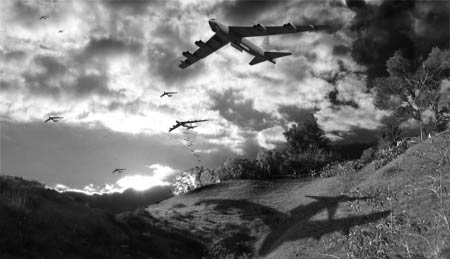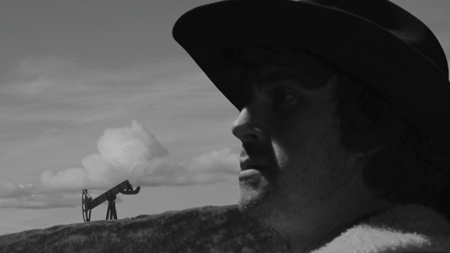Kurzfilm
Strange Love
Kurzfilm, 2010 / 5 Min / US (HD)
Distributed by sixpackfilm
“Der bizarre Fiebertraum einer Apokalypse in Schwarzweiß.”
Der Standard
Idyllen, in denen sich Irritation auftut: Strange Love von Richard Wilhelmer (produziert am California Institute of the Arts), zeigt uns dies und impliziert dabei Einvernehmen mit uns darüber, dass es mittlerweile normal ist, in idyllischen Anblicken immer und überall Irritationen zu sehen. Getrübte Idylle ist heute ein vertrautes, gern gesehenes, leicht lesbares, idyllisches Bild. Umso mehr weiß man nie. Ein Golfplatz glüht in Schwarzweiß und Abendsonne; eine Sirene heult; ein Schwenk weist zum Himmel. Dort taucht ein Jet so punktgenau aus den Wolken auf, dass es erst wie ein Zufall wirkt; als dann mehrere Jets den Himmel übersäen, wird klar: Es ist Krieg. Also: ein Bild vom Krieg. Zumal das folgende, das all die B-52-Bomber aus der Nähe zeigt: Es stammt wohl aus diesem Filmklassiker, auf den Titel und Schriftzug hier anspielen. Alles ist vertraut – aber: Mitten in der allzu idyllischen Jet-Formation fliegt ein Stealth-Bomber, wie es ihn zu Zeiten von Kubricks Dr. Strangelove längst nicht gab. Das Bild sieht aus, als wär es von Kubrick, das dazu von fact, fiction, contradiction kündende Lied klingt, als wär es von Klaus Nomi. Die Voice-over klingt nicht danach, ist aber die von James Benning (einem seinerseits mit Himmel, Landschaft und Alltagsbildirritation befassten Filmemacher). “I love you like I love the bomb”, sagt er: Im Bild ficken zwei junge Amis, Mann und Frau, während im Hintergrund Bomben auf Hügel hageln. Kubrick sah die Beziehung von Technik und Sex umgekehrt: I love the bomb like I love you. Die strange love von gestern ist das Idyll von heute. Dem bringt Strange Love die seltsam normale Liebe namens Nostalgie/Cinephilie entgegen, und zwar im Modus ihrer Selbstaushebelung. Sex mit Todestechnik, Friedensrune, Atompilz-Apokalyptik: Die Bildkultur des Kalten Krieges verweist hier auf unser Heute. Heute ist Krieg wohltemperierte Polizeitätigkeit, tendenziell immer und überall. Und die US Air Force bombardiert Amerika. (Drehli Robnik)
FESTIVALS:
WRO – Media Art Biennale, 2011 (PL)
Edinburgh Int. Film Festival, 2011 (GB)
22nd Sao Paulo Int. Short Film Festival, 2011 (BR)
Diagonale 2011 – Festival des Österreichischen Film (AUT)
40th Festival Du Nouveau Cinèma, 2011 (CA)
23rd Istanbul Int. Short Film Festival, 2011 (TR)
Impakt Festival, 2011 (NL)
exground Filmfest Wiesbaden, 2011 (DE)
16th Int. Festival of New Film Split, 2011 (HR)
Limassol – Cyrus Short Film Festival
6th NEXT Int. Film Festival Bucharest, 2012 (RO)
Lima 12 – Peru Int. Short Film Festival (PE)
“BERLINER” Screening at the Goethe Institut – New York, 2012 (US)
26. Stuttgarter Filmwinter 2013 (DE)
Shortfilm, 2010 / 5 Min / US (HD)
Distributed by sixpackfilm
Idylls that hold some irritation in store: Richard Wilhelmer’s Strange Love (produced at the California Institute of the Arts) shows them to us, implying our agreement that seeing irritations in all idyllic views is now normal. Gloomy idylls have come to represent familiar, popular and easily comprehended idyllic scenes. You can never tell, even more so.
A golf course glows in black and white and the evening sun; a siren wails; the camera pans to the sky. At that moment a single jet appears in the frame, seemingly a coincidence at first. Then, when the sky fills with them, the situation becomes clear: It’s war. To be precise, a scene of war. This is made even clearer when closeups of all the B-52 bombers are shown in a scene probably taken from the classic film that the title and lettering style refer to. Everything’s familiar, but: A Stealth bomber’s flying in the center of this all too idyllic formation of jets, a model that didn’t exist in the days of Kubrick’s Dr. Strangelove.
The scene looks as if it were made by Kubrick, the song about “fact, fiction, contradiction” could be Klaus Nomi’s. The voiceover doesn’t sound like it, but it’s James Benning (a filmmaker who dealt with skies, landscapes and everyday irritations). “I love you like I love the bomb,” he says: Two young Yanks, a man and a woman, fuck as bombs fall on hills in the background.
Kubrick’s view of the relationship between technology and sex was the other way around: I love the bomb like I love you. Yesterday’s “strange love” is the idyll of today. And Strange Love meets this with the strangely normal love known as nostalgia/cinephilia, in self-annulment mode. Sex with the technology of death, rune of peace, mushroom-cloud apocalypse: The Cold War’s visual culture points to our present day. All war tends to be a well-tempered police action now. And the US Air Force bombs America. (Drehli Robnik)
Translation: Steve Wilder


